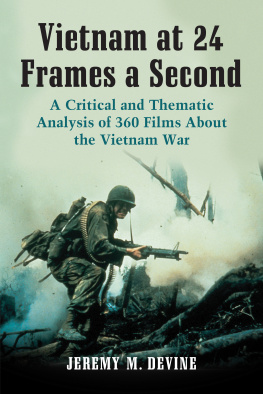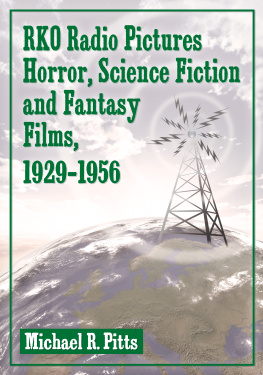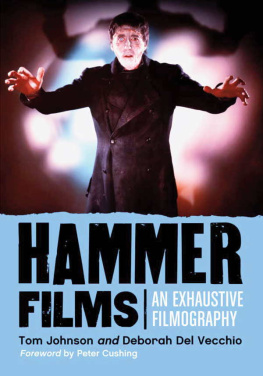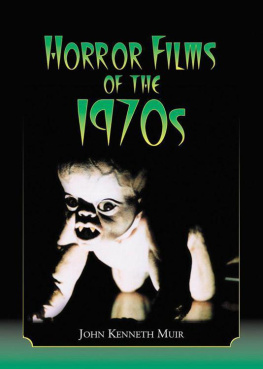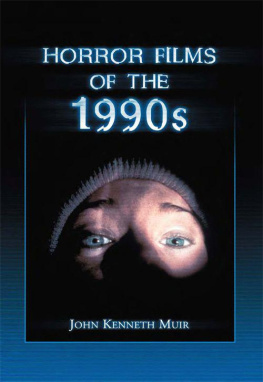
Vietnam at 24 Frames a Second
A Critical and Thematic Analysis of 360 Films About the Vietnam War
JEREMY M. DEVINE

McFarland & Company, Inc., Publishers
Jefferson, North Carolina
LIBRARY OF CONGRESS CATALOGUING DATA ARE AVAILABLE
BRITISH LIBRARY CATALOGUING DATA ARE AVAILABLE
e-ISBN: 978-1-4766-0535-7
1995 Jeremy M. Devine. All rights reserved
No part of this book may be reproduced or transmitted in any form or by any means, electronic or mechanical, including photocopying or recording, or by any information storage and retrieval system, without permission in writing from the publisher.
On the cover: Hamburger Hill, 1987 (Photofest)
McFarland & Company, Inc., Publishers
Box 611, Jefferson, North Carolina 28640
www.mcfarlandpub.com
Dedicated to Nancy,
with love and appreciation,
and to Alex and Sam,
with the hope that their generation knows peace
Acknowledgments
This book would not have been possible without my dear wife, Nancy. Aside from her assistance in word processing and editing, she kept me going when the task seemed insurmountable. She always believed in me and the project. Additional thanks are due to Judith Holz and Laura Nelson for their editing assistance and feedback.
Introduction
As far back as 1898, when motion pictures were in their infancy, a short film entitled Tearing Down the Spanish Flag rallied its viewers to the American cause in the Spanish-American War. The very first film to win the Oscar for Best Picture in 1927 was the war film Wings, a tale of World War I flying aces. During the course of World War II nearly 450 features were made about the conflagration (see Tessa Horans F.Y.I., Premiere, May 1991, p. 15). Although the Korean conflict, Americas forgotten war, had only nine releases concomitant to the hostilities, throughout the history of film, a body of work known only since 1896, war has provided one of the most compelling subject areas. Inherent in it is a panoply of human emotion, tragedy, and spectacle that lend themselves to the salient medium.
Conventional wisdom correctly tells us that many of our images and opinions of war are shaped by what we have seen on television or in film. The written word recedes in the wake of the electronic media and instantaneous satellite imagery exemplified by the coverage of the Persian Gulf War. Especially for our youth, the unforgettable moments are not what was gleaned from an astute author on the op-ed page. Rather, indelibly marked on the collective conscious are CNNs reports from Baghdad under air assault, the pitiful surrender of Iraqi troops to allied forces and ABC cameramen, or the dramatic, live, all-network briefing by General Schwarzkopf.
When America went off to fight communism in the jungles of Vietnam, twenty years of glorious World War II imagery from films accompanied the troops and policymakers. But something went awry in Southeast Asia. For the first time the United States lost a war and with it a great deal of pride, innocence, and many lives. Only one film was made about the Vietnam War during the conflict itself. Most appropriately that was the very personalized work of a man who exemplified gung-ho Americana, John Wayne. His instantly dated and reviled film The Green Berets was released in 1968.
As the consensus about the Vietnam War unraveled, Hollywood reacted as any for-profit business would; it retreated from the unpalatable. No longer could it serve its traditional propaganda-boosting role or entertain in a conventional sense. Therefore it was not until two years after the fall of Saigon in 1975 that the now-familiar Vietnam War films such as The Deerhunter and Coming Home were released. Since that time the casual observer might be able to mention only a handful of films about the hated conflict. They probably include Apocalypse Now, Platoon, and Born on the Fourth of July. Upon reflection one might also call to mind The Boys in Company C, Hamburger Hill, or Full Metal Jacket. Perhaps the important Rambo and MIA movies might also be discerned.
Correcting the notion that there have been relatively few Vietnam War films is what fills the pages of this book. Critical commentary is offered on more than 400 feature-length motion pictures. In attempting to be comprehensive, I have included discussions of many films that admittedly make merely tangential reference to the war. However, as a unique and tragic chapter in American history, the Vietnam War had a rich historic base not just in the jungles of Southeast Asia but also in the domestic issues of conscription, protest, veteran reintegration, loss, and rebirth.
This work begins with the dawn of the cold war in 1948, a period reflecting the background basis for the belief systems that led us into the conflict. It continues through the 1950s and the war years of the 1960s and early 1970s, then the aftermath and beyond, even into the future of the 1990s. This represents nearly a half-century body of work. This book runs the gamut of genres. Surprising to some will be the fact that critical attention is paid to horror films, comedies, and even one musical, as well as the anticipated plethora of dramas, actioners, and adventure tales.
This book is necessarily limited primarily to English-language and fictional works. Therefore by self-imposed definition many fine documentaries and foreign films are not discussed. However, rules, particularly self-imposed ones, are made to be broken. Thus there are a few French, Vietnamese, and other foreign films examined in these pages. So, too, a limited number of documentaries that received the rare general release are also included.
An attempt is made to place each chapters era in its historical context. This takes the form of brief introductory passages that describe what was happening in the war and the greater world stage at the time of the films releases. Utilizing a chronological approach to the subject best allows this essential integration of the reel and real worlds. In addition, the evolution of imagery becomes more apparent and speaks in a subtly patterned totality to the changes in perspective toward the war as reflected and as created by the films.
One other matrix is laid over the progression of film discussions to help in understanding the images. That is the dynamics of the film industry itself. The production, exhibition, and distribution of feature-length films is a fascinating process that exemplifies the often uneasy coexistence of artistic and business concerns in the American society. Far from tending to eliminate Vietnam War films, the programming or software concerns of the industry have dictated a contextualization of the relevant films. Vietnam as a subject has been part of the evolution from double features to drive-in flicks to made-for-television movies to made-for-video and cable releases. Each of these facets of the medium has contributed to the ranks of films discussed in the following pages.
As a practical note, in the video age it is relatively easy to gain access to many of the titles in these pages, and the reader is strongly urged to view these motion pictures. In many instances in the context of production histories, plot synopses, or commentary, I have revealed the endings or dnouements. Therefore, the reader who does not want such information is forewarned. One can either preview the movie or consult the index to determine the latter pages of a discussion of a particular film and skip them until after viewing. For the busy student or more casual reader, the entries are designed to be informative and not necessitate frequent, costly, and time-consuming rentals. However, as clearly defined by the relative length of certain treatments, some films are more important than others to this study and deserve viewing.
Next page
